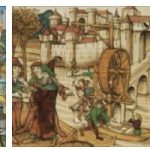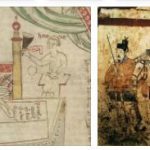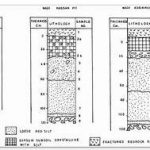With the end of the century. IX opens a new period in the history of Germanic law: the period that is properly called the Middle Ages (for the previous period, see Germanics, peoples: Law). It spans the centuries of the Middle Ages from the end of the century. IX at the end of the century. XV. It is a period of transition, in which the elements for the formation of society and modern law are being prepared.
From the ruin of the Carolingian empire the Germanic national kingdom had arisen, made up of German lineages united in their own political unity. With the Verdun treaty of the year 843, which marks the division of the Frankish kingdom from the Italic kingdom and from the properly Germanic kingdom (see Germany: History) the German peoples of the eastern part of that empire, speaking the Theudisca language, that is the language vulgar, they are distinguished from the others of the western parts, speaking the Latin language, and thus we have the birthplace of the German nation properly. Under the power of Lodovico the German, a kingdom was formed, which later, in the 11th and 12th centuries, was called Teutonicumor Regnum Germaniae, the proper basis of the new Gemanic law. But this territory too had undergone a profound influence of Roman law; and therefore even the constitution of this independent kingdom, if it marks a less uncertain orientation towards the forms of local law, nevertheless does not detach itself from those civil currents coming from the West, which had already pervaded it. Then when the Germanic kings, Arnolfo, Otto and successors, Henry II and his descendants, also assumed the dignity of king of Italy and emperor of the West, Germanic law found itself again approached to Roman law, until in the century. XV, there was the integral acceptance of the Roman-common law or Italian law, which, except for slight differences, became the common law of Germany in modern times.
During this medieval period the great duchies were divided into the feudal system in Germany; the struggle for investitures, and then the development of territorial principalities, which characterize the new constitution of the modern age. In the constitution of the Germanic kingdom in the medieval period, the class of simple free men was further reduced, and the noble classes were strengthened, which included feudatars, princes and barons, and knights, together with the various categories of chivalry; while there are numerous plebeian, rustic (Gemeinfreie), pertinent (serfs), census (Grundhörige), or real servants (mancipia, Eigenleute, Leibeigenen) classes). However, among the knightly classes there are now numerous ministerial ones, linked to a service relationship with the lord (Dienstrecht), but endowed with privileges; and in the plebeian classes, in the meantime, the bourgeoisie, that is, the residents of the cities, distinguished themselves, gaining the full rights of liberty, who are becoming more and more numerous also in Germany, from which the third state will be formed. The organization of these various classes implies the prevalence of the principle of equality (Ebenb ürtigkeit) whereby people of the same category (pares, coaequales) are distinguished from those of other classes, gaining independent jurisdiction and rights. The reflection of these distinctions can be seen in marriage with a woman of a lower category, which gives rise to a disparagium (Missheirath).
In the life of law, in this period there is a tendency in Germany to create new forms, produced by custom, and to forget the codification of the previous age. Therefore, in the face of the system of the personality of law, that of territoriality prevails. The Volksrecht, Stammesrecht, becomes territorial or provincial law, ie Landrecht. Particularism manifests itself. However, there are regions of the Germanic kingdom which remain under the influence of Frankish law, such as Swabia, Bavaria, Thuringia; on the other hand, Saxon law resists Frankish law, and manifests a marked individuality, which also produced an independent doctrinal work. This explains the division into two groups, outlined by the golden bull of 1356, between the group in Franconian iure and the loca ubi saxonica iura servantur. A kingdom legislation is preserved, which starts from the territorial peacekeepers (constitutiones pacis or Landfrieden), aimed at limiting the feud or private wars and reprisals; but which then takes place in the constitutiones of the Germanic kings and emperors, among which the constitutio de regalibus, enacted in Roncaglia, next to a constitutio pacis, and then the series of other peace constitutions deserve mention. The bulla aurea, promulgated in the diet of Nuremberg and then in that of Metz in the year 1356, was the fundamental law for the election of the king and for the rights of the electors.
But faced with the scarcity of Germanic laws, there is a large number of particular or provincial laws. There was a particular law of Friesland (12th century), an Austrian provincial law (13th century), a provincial law of Upper Bavaria (14th century), alongside numerous Landrechte derived from the particular customs of the countries. In this current must also be enumerated the municipal laws or statutes, which consisted in privileges, in customs, in true and proper statutes. From the century XIII we find that even in Germany the cities are endowed with autonomy and with their own regulations, for which there were the Stadtbücher or municipal books, the Stadtrechte or municipal rights, the collections of customs. The most important of the municipal rights was that of Magdeburg, based on Saxon law; but the law of Lübeck, that of Hamburg, of Goslar, of Eisenach, of Dortmund and so on, which are based on the same juridical source, was also widespread. Municipal rights based on Franconian law were those of Aachen, Cologne, Frankfurt, Bamberg. Generally it can be said that the oldest municipal texts were found in Franconia, Lotharingia, Alsace.
All these rights that we have enumerated were rights of independent cities, with their own juridical development, and these, almost always having an appeal court (Oberhöfe), had the character of mother cities (Mutterstädte) : the smaller cities, which gradually came arising in Germany, they received the law and statutes of the mother cities, and figured as derived cities (Tochterstädte), and were obliged to conform to this legal dependence (Bewidmung). Then there were texts of rustic law, which collected the local customs, also called rotuli, Rodel. The fundamental collection of the Weisthümer Germans was made by Grimm, in seven volumes (1840-1878). Finally there were numerous texts of feudal law, privilegia ministerialium, Hofrecht, which were then overwhelmed by the prevalence gained also in Germany by the Libri feudorum (see feud), a compilation of Lombard feudal law formed in Lombardy between the end of the century. XI and the first half of the century. XII, which became a common law for all the lands of the Western Empire.
The juridical books hold a particular position among the sources of Germanic law, that is the jurisprudential works that aim to summarize and clarify the law of the various territories. In this species, the most distinguished and oldest work is the so-called Saxon Mirror (Sachsenspiegei), a systematic treatment of Saxon law, due to the chancellor and scabin Eike of Reppgau or Reppichau, between the years 1234 and 1235. The work is divided in two parts: Landrecht or provincial law and Lehenrecht or feudal law. The first part, the most important, was, in the century. XIV, divided into three books. It was originally dictated in Latin, but the same author translated it into the Lower Saxon dialect, at the request of Count Hoyer of Falkenstein. The text has bizarre inventions and inaccuracies, but it is useful for the reconstruction of Germanic law and was widespread.
From the Saxon Mirror, which describes the law and jurisprudence of northern Germany, derive two texts, which describe the law of the southern part of Germany: the German Mirror (Deutschenspiegel) and the Swabian Mirror (Schwabenspiegel). The authors of these two texts, who did not have the fortune of the first, are unknown. The German Mirror was perhaps compiled by a practical jurist from Augusta between 1235 and 1275, on the basis of the Saxon one, as well as various Roman sources, or statutory canonical sources; but its most interesting part concerns the law of southern Germany. The Swabian Mirror, slightly later, he tries to perfect the work of the German one, keeping the Saxon Mirror even more strictly as a model, but referring more especially to the Alamanno law. The Swabian Mirror, perhaps compiled by a priest, with political tendencies diverging from those of the Saxon Mirror, was widely disseminated. The Saxon Mirror and the Swabian Mirrordetermined a legal literature, which contributed to the development and knowledge of North and South Germanic law.
The political constitution of this period is based on the fiefdom, and therefore reveals the extreme fragmentation of the country. The kingdom is elective, and the principle of election prevails over dynastic tendencies, which would have liked to have a principle of hereditary succession triumph. Election is the privilege of electoral princes, and its regulation is fixed in the golden bull of 1356. From the end of the 13th century, after the extinction of the Swabian dynasty, the elections are aimed, with alternating fortune, on three families, Wittelsbach, Luxembourg, Habsburg. From Albert of Habsburg onwards (1438), the crown of Germany always remained in the Habsburg dynasty until its extinction. Under the influence of the Saxon Mirror, it was determined that the right of election belonged, in the front line, to the three archbishops of Mainz, Trier and Cologne, and to those secular princes who covered the supreme palatine dignities: to the count Palatine of the Rhine (archdapifer), to the Duke of Saxony (marshal) and to the Margrave of Brandenburg (treasurer). One of the supreme dignities of the palace was excluded, that of the archbearer, held by the king of Bohemia; but the law of the latter triumphed over the end of the thirteenth century. Thus was formed the electoral right of the seven electoral Palatine princes. The golden bubble established the principle of the majority, and the rules of the elections. Later there were some additions.
From the election to the throne of Otto I, by virtue of the imperial crown assigned to him by Pope John XII in 967, the rule that the king of Germany should obtain the authority of emperor had prevailed. Now, since, according to the dominant idea, the king of Germany also had the right to be king of Italy and king of Burgundy, there was in fact an extension of power of this prince, who rose to the honors of the Empire, and assigned the title of Rex Romanorum to the presumptive heir to the crown. But the imperial dignity was given by the pontiff. Hence the struggle for dominance between pope and emperor, which fills the whole of Germanic history from the time of the Ottos to Charles IV. The theory of the subordination of Unam sanctam (1307). But against these claims, at the time of Lodovico the Bavaro, the principle was affirmed that the election to king of Germany already conferred the imperial title without the papal coronation, except that the principle was contrary to the custom followed until then. In fact, however, the coronation in Rome became less and less frequent, until in the century. XVI ceased entirely.
The royal court was made up of the palatine dignities mentioned above, by the iustitiarius Curiae, introduced in 1235 on the example of the Kingdom of Naples and Sicily, by the magister Curiae (Hofmeister), an office existing from the time of Henry VII onwards, split into a domestic dignity (Haushofmeisteramt) and a higher dignity (Oberhofmeisteramt); the former held the functions of domestic prefect, the latter powers of government. The court offices, which primarily had state functions, were the comes sacri palatii and the palatine chapel, which served as chancellery.
In the provincial administration, on the still enduring system of counties and centenas, in the single major and minor districts, the great duchies or duchies of lineage (Stammesherzogthum) become very powerful, to which at the time of the Othons, as a counterweight, oppose the Palatine counties of lineage (Stammespfalzgrafschaft), those of Lotharingia, Saxony, Bavaria, Swabia. Later the Palatine counties disappeared and only the Palatinate of Lorraine, known as the Rhine (Pfalzgrafschaft), remains. Great importance had the frontier marks, especially the eastern one, which is linked to Austrian history, and that of Carinthia.
The magistracy of the Langravii (Landgrafen, comites provinciales, magni comites) also frequently recurs, which seems to be a title of distinction given to the major accounts. Through these dignities, the various Germanic territorial principalities are formed, which continue, with fairly stable borders, until the modern age.
According to top-mba-universities.com, the diet of the kingdom (Reichstag) is made up of the great dignitaries or vassals summoned by the crown, to negotiate the most serious affairs; but its calling is the king’s exclusive right, so that it gradually loses its importance.
To the class of the great of the kingdom also belong some major ecclesiastical dignitaries, who are ecclesiastical princes, as holders of the bishoprics and abbeys of the kingdom (Reichskirchen). In accordance with the concept of private or patrimonial churches (Eigenkirchen), the properties of the royal churches were considered as property of the kingdom and only in the useful possession of the churches themselves. Long struggles took place on this royal right, also complicated by the definition of investiture law, leading to the act of Worms (1122) and then a series of other provisions on the right of regalia.
With the development of the central legal systems there was also a more organic judicial system: central courts were established, formed by the courtly court (Reichshofgericht, Pfalzgericht) and by the ducal courts, in the great duchies. Then there were the brand courts, the county courts, the superior law courts, and finally the inferior or ordinary courts. With the rise of city autonomies, provincial courts (Landgerichte) were formed under which the minor local courts were located. The so-called Femgerichte had a characteristic position in southern Germany, mainly in Westphaliaor criminal courts, to which criminal matters were reserved. There were also all the different feudal, ministerial, rustic, ecclesiastical courts and so on, with infinite complications, which custom alone was able to clarify.
On the end of the Middle Ages, Germanic law, on the basis of its ancient and new customs, and due to the influences of Roman and canon law, presents an extremely complicated aspect, which justifies and explains the phenomenon of the Reformation.









